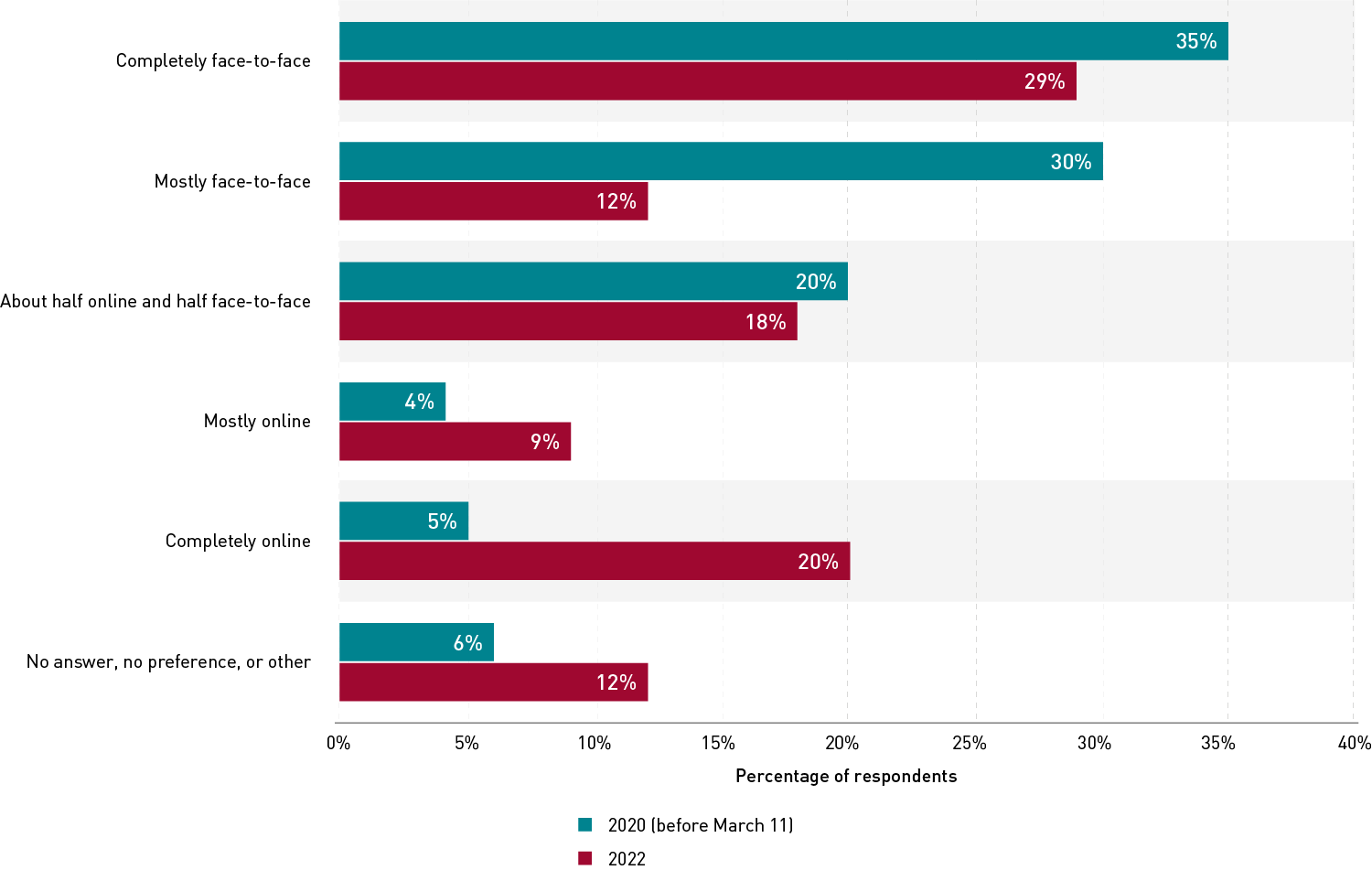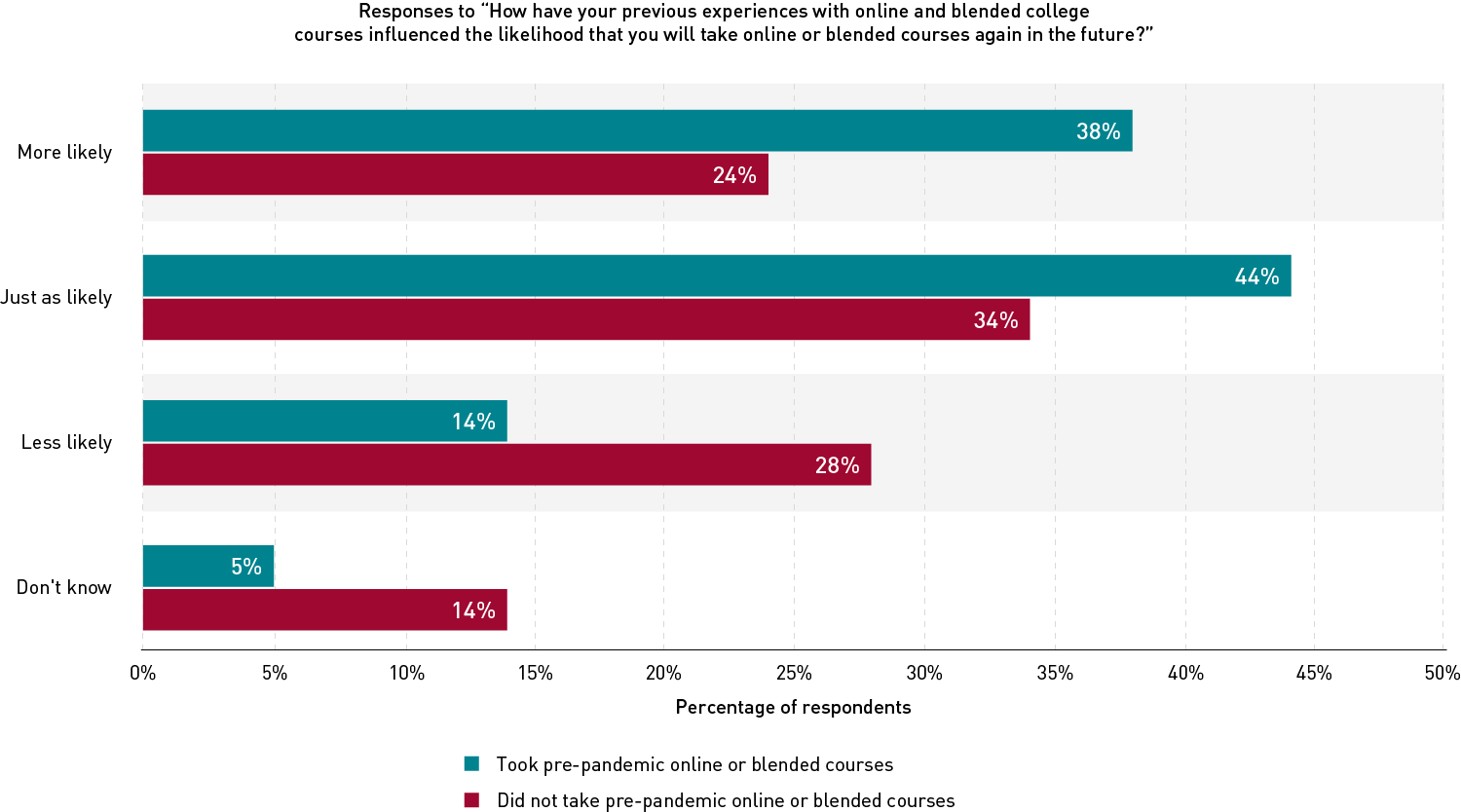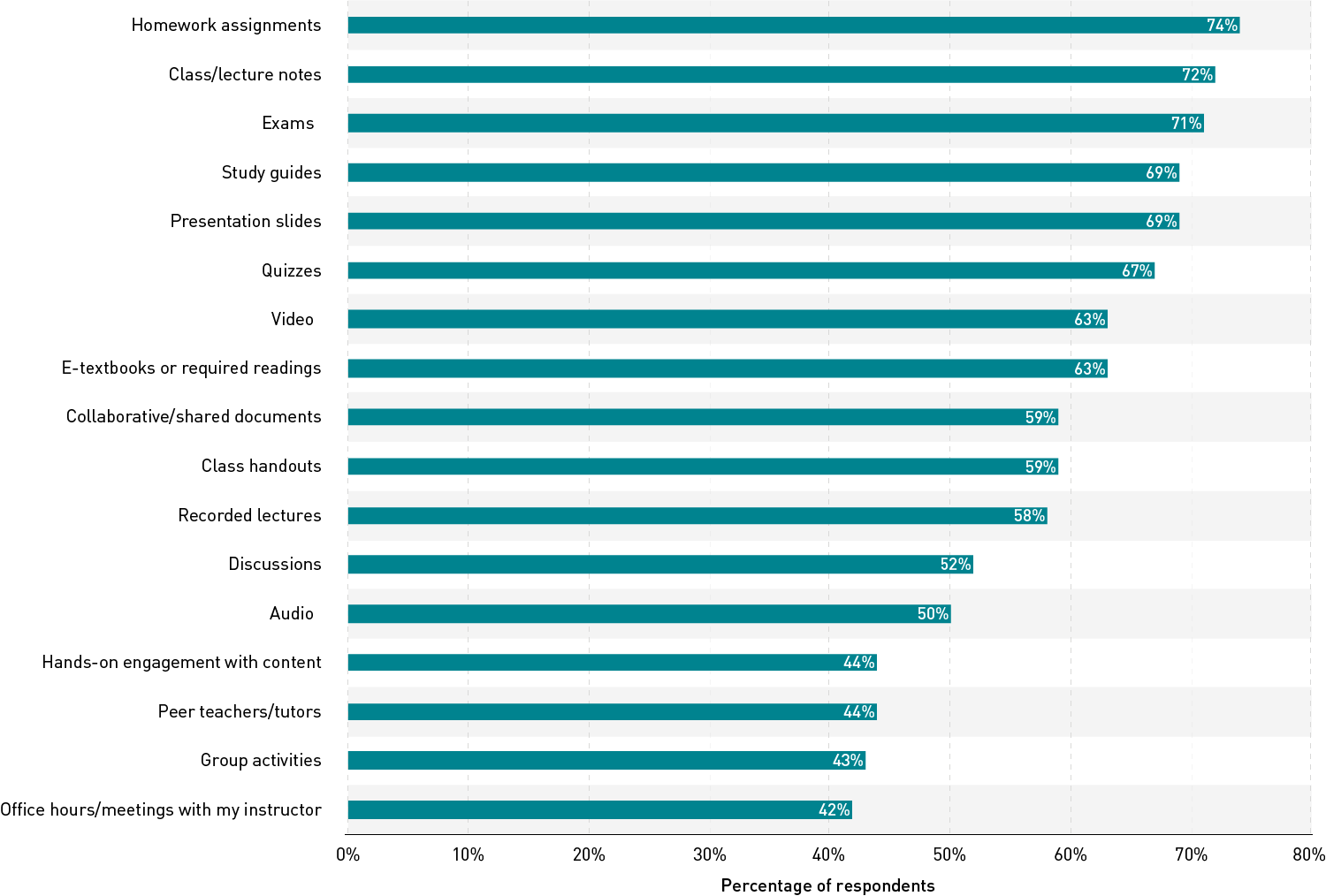Modality Preferences
The internet is coming! One of the hottest topics in higher education these days is the future of instructional modalities. Survey data reveal an interesting trend in students' stated preferences. In comparison to pre-pandemic data about course modality preferences, students are now expressing stronger preferences for modalities that are mostly or completely online (see figure 3). In fact, the percentage of respondents indicating that they prefer mostly or completely online courses increased more than three-fold from 9% in 2020 to 29% this year.1

Taken alone, these data do not reveal much about the reasons for students' preferences, and understanding those reasons is going to be important for designing future course offerings. An exploration of open-ended comments from respondents reveals that they want to use different modalities for different purposes.
A Note on Modality
We recognize that instructors, students, administrators, instructional designers, and other stakeholders have not come to a consensus on the way instructional modalities are labeled and operationalized. Terms such as "online," "online synchronous," "online asynchronous," "hybrid," "blended," "HyFlex," and "face-to-face" continue to mean different things to different people. Delving more deeply into these nuances was outside the scope of this research, so we simply asked students about their experiences with "online," "blended (i.e., partially online)," and "face-to-face" courses more broadly. For specific wording of any survey item, please see the full survey instrument.
For more resources on modality, visit the Digital versus Brick-and-Mortar Balancing Game Showcase.
Students' preferences for online modalities are related to meeting personal needs. Respondents provided open-ended responses to the question "When you take courses that are not delivered in your preferred mode, how does that impact your learning experience (if at all)?" Some respondents who indicated that they prefer mostly or completely online courses explained that these modalities make it easier for them to accommodate disabilities:
"I am able to learn easier in online classes. I can accommodate for my disabilities easier, and I have the ability to go back and rewatch lectures if I missed some for whatever reason."
"I have a hard time with focus and auditory processing due to my disability; with in-person lectures, I often miss important details about the material and due dates."
Others referenced circumstances such as caring for family members and maintaining work schedules:
"[Taking face-to-face classes] significantly hinders my ability to perform essential weekly activities, taking care of grandparents/parents."
"I won't be able to finish my degree unless I can do it online. My dad is in remission from cancer and doesn't have any protection from COVID."
"Having to commute would be more stressful. It would probably negatively impact my learning because I have a job that I have to prioritize over school with regard to my schedule."
Some respondents who indicated that they prefer mostly or completely online courses said that taking courses in other modalities does not impact their learning experience. In fact, some respondents even pointed out that there can be advantages to taking courses in other modalities.
"I don't think it [impacts my learning]. I can take my courses any way but like the online classes."
"My learning experience is impacted in a way that is a little more fun since I get to meet and work with the classmates and get to know the professor."
Students' preferences for face-to-face modalities are related to social interaction and engagement. Respondents who prefer mostly or completely face-to-face courses described challenges related to social connection and engagement when online:
"I feel more isolated and alone if I am not taking a face-to-face class."
"I feel like I don't pay enough attention. I'm on my own, compared to when I am in lecture with the teacher explaining it. So I feel I don't learn as much because when I'm all alone I don't read the work as closely."
"Online and hybrid classes negatively affect getting to know the teacher and them getting to know you, and it's too easy to not know what's due when."
"[It is] harder to connect with classmates for study sessions."
These data are consistent with respondents' preferences for meeting with other students for academic work. Nearly half (49%) of respondents indicated that they prefer meeting each other either mostly or always face-to-face (see figure 4). Even when considering course modality preferences, about one in five (21%) respondents who prefer completely online courses still prefer to meet other students for academic work face-to-face at least half the time. Taken together, these findings both inform the design of hybrid learning modalities and suggest that there is an opportunity for educators to create and foster better opportunities for social interaction in online modalities.

Past experiences influence future choices. To investigate potential reasons for students' modality preferences, we asked them how their previous experiences with online and blended college courses influenced the likelihood that they would take online or blended courses again in the future (see figure 5). More than half (59%) of respondents overall said that, on the basis of their previous online and blended experiences, they were more likely or just as likely to take such courses again in the future. Among respondents who had taken online and blended courses before the pandemic, however, this figure rises to 82%, while for those who first experienced online and blended learning during the pandemic this figure is just 58%. Meanwhile, 14% of respondents with pre-pandemic experience taking online and blended courses said they were less likely to take such courses in the future, compared to 28% of respondents who had no pre-pandemic online or blended courses.

These data suggest that the challenging environment of emergency remote instruction might have contributed to some students' concerns about online and blended courses. Alternatively, students who engaged in remote instruction before the pandemic might have been better positioned to succeed in remote learning environments or might be enrolled at institutions that already had the infrastructure required to support emergency remote instruction. Further research in this area will help institutions determine how to best support remote instruction in the future.
Would a modality by any other name be just as sweet? Higher education leaders continue to wrestle with the definitions and designs of instructional modalities. To contribute to this work, we asked students how important it is for them to have online access to specific instructional elements (see figure 6). In alignment with previous EDUCAUSE research, nearly all respondents (99%) indicated that two or more items on the list were at least slightly important to have online, and more than half (56%) of respondents indicated that all 17 items on the list were at least slightly important to have online. Further, every item on the list was ranked very or extremely important by at least 42% of respondents. Even when taking modality preferences into account, these patterns hold true. Every item on the list was ranked very or extremely important by no fewer than 39% of respondents who indicated that they prefer courses that are completely face-to-face. These data point to student demand for online instructional elements, even for fully face-to-face courses.

Note
-
The 2020 data were collected before the announcement of the global pandemic by the World Health Organization (WHO) on March 11, 2020. Previous reports of the 2020 data did not include the "No preference" responses in their calculations and may not match the more complete data reported here.
↩︎